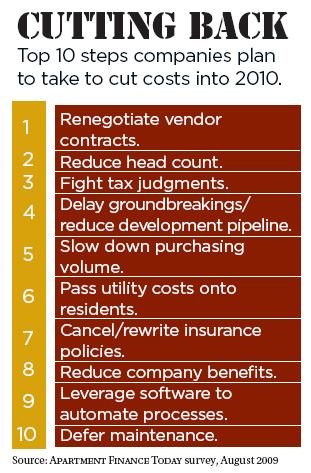18. Optimize Your Occupancies.
While minimizing vacancies is also a key strategy for many in an environment where prospect competition and costs for leads-to-leases are at all-time highs, some multifamily operators are both questioning the full-up strategy, and cautioning against it in as much as higher occupancies are becoming dilutive to effective rents.
“I’m always amused with these great stories about occupancies that are really stories about physical occupancy,” says Campus Advantage’s Peter. “That can often have little relationship to what your revenues are looking like, and occupancy at the expense of NOI is rarely a good thing.”
The Connor Group plans to take effective rents one step further in 2010, asking on-site personnel to deliver a 90 percent occupancy that maximizes effective rents rather than pushing for a full house. “Economic occupancy as compared to physical occupancy is always a far better gauge of asset health and value,” Connor says. “We could be 95 percent occupied but running at only 85 percent occupied relative to effective net market rents, and I think that’s the situation a lot of firms are finding themselves in. It’s far smarter to be only 92 percent physically occupied but to be at an 89 percent or 90 percent economic rent level.”
19. Burn Off Concessions.
A primary tactic in improving net effective rents, of course, is eliminating concessions at the door, a difficult step to take for site managers being pressed to convert leads and maintain property stabilization even as they are being asked to cut operation costs and simultaneously seek out new revenue. Nevertheless, concession burn-off will be part and parcel of any recovery in multifamily rent fundamentals. And as usual, firms operating ahead of the curve stand to benefit from earlier and more robust improvements to NOI.
“Concession burn-off is a major factor in 2010, and that burn-off factor has to occur before you see real rent growth,” Nadji says.
Like many firms, ZOM will continue to leverage yield management software as a way to reduce blanket market concessions and improve pricing sophistication at the asset level. “But what we are bleeding from are the enormous rent discounts and enormous commissions for apartment locators to bring people to our properties,” Patterson says. “The decline of those kinds of business practices is decisional, and it is something that we have to wean ourselves from. Our successes there will have more impact on NOI at multifamily properties than anything else over the next two to three years.”
20. Maximize Renewals.
Rather than even deal with pushing rents in a concession-laden environment, most firms are taking a nail-the-windows-shut approach to resident retention in 2010, refining strategies put into play across 2009 to keep heads in beds and effective rents high and healthy.
UDR has gone so far as to turn its renewal process into what Toomey calls a “resale process”—presenting renters a range of options at renewal time that include more space, greener options, perhaps better finishes, all geared towards an up-sell with a common denominator of keeping the resident in-house. “You have to look at this window of time and rethink the thought process around renewals.”
As a last resort, retention might even mean offering a market-rate rent reduction to the renewing resident, sans concessions.
Regardless of approach, retention in 2010 is likely paramount to any other on-site strategy for maximizing opportunity and success in a year of change. “We should be renewing a higher percentage of our rentals next year than we ever have before,” says ZOM’s Patterson. “If we don’t get that accomplished, then I think we have failed.”
